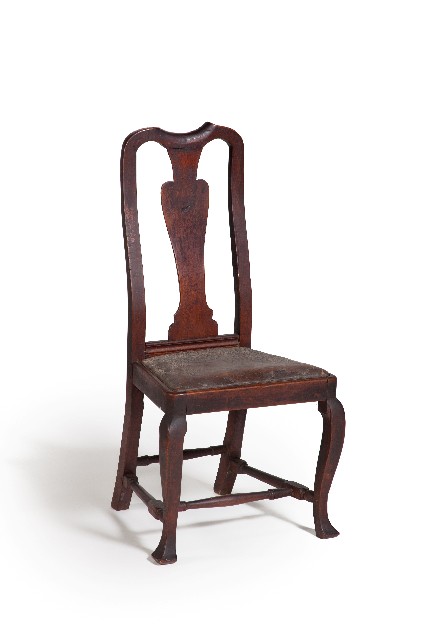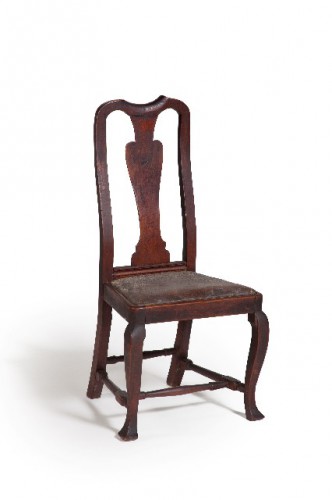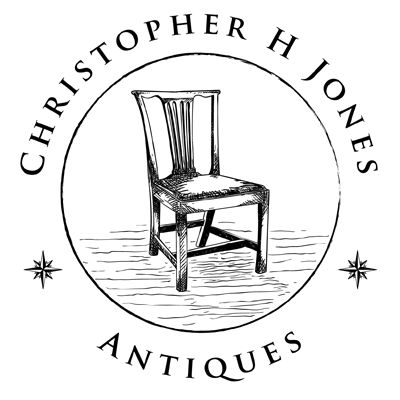“Crook’t Foot” or Cabriole Leg Side Chair
With an Original 18th Century Leather Seat and an Outstanding First Generation Surface Throughout
Possibly Solomon Fussell
Philadelphia, Circa 1735
Soft Maple (Acer sp. by microanalysis) with Yellow Pine Framed Slip Seat
Dimensions: Height – 36 ¾” overall, 16 ½” at seat rail, Width 21 ½” overall, Depth 19”
Commentary: This recently discovered chair in a remarkable state of preservation predates the work of William Savery and represents an important new element in the study of Philadelphia chair making in the first third of the eighteenth century. A great deal of scholarship has been devoted to clarifying the evolution of Philadelphia made chairs as local artisans responded to the competition for market posed by Boston imports. Along with the overall form and stylistic embellishments, much attention has focused on the types of finish, upholstery, particularly leather seats and backs. While the form, construction and extraordinary surface of this chair provide unsurpassed insight into the materials and techniques utilized by its maker, the survival of the original leather seat and frame – an important and costly upgrade – presents a complete example of a Philadelphia made side chair as it was produced.
The chair belongs to an early group of Philadelphia “Crook’t Foot” or cabriole leg chairs that were long thought to have appeared in that city considerably later than in Boston. Horner dated the introduction of the cabriole leg, and the Queen Anne style, to 1738 based on his reading of Solomon Fussell’s 1738-51 ledgers. As used by Fussell, the term “crook’t foot” referred to the entire leg, and represented an expensive additional feature. In his 1980 study of Fussell and his apprentice, William Savery, Benno Forman noted that the ledger referred to by Horner been preceded by at least one and possibly more earlier accounting books and concluded that the date of this feature’s introduction by Philadelphia chair makers. By 1738, the crook’t leg chair was a common rather than high style feature and the Fussell shop was offering the form in a variety of seat and back configurations constructed of components sourced from a number of specialist artisans. In addition to this range of options, noted Foreman, “One of the most significant insights gained from the Fussell ledger is the fact that virtually every maple slat-back chair was “colourd’ or “dyed.” Black and brown are the colors mentioned most frequently; “reed,’ or red, is listed twice and orange once.” (Significant areas of this chair appear to retain the original finish applied at the time of production and with analysis could reveal important new insights into the materials and techniques employed in the period.) Likewise, upholstery and in particular the option for leather seats, was of great interest to chairmakers and their clients. Boston products were readily available with leather seats of various colors and Philadelphia upholsters such as Plunket Fleeson countered by offering local wares “as cheap as from Boston.”
While the earliest labeled Philadelphia examples of the crook’t foot chair style yet discovered came from the shop of William Savery, Philip Zimmerman has identified an even earlier group distinguished primarily by the presence of an unusual and redundant second rail above the seat rail. The group, discussed by Zimmerman in a series of articles concerning Philadelphia seating furniture, includes a close stool arm chair at Stenton and a pair of side chairs at Wright’s Ferry Mansion. After surveying these examples and the known Savery chair, Zimmerman concludes, based on , small differences in design and construction, that they were not Savery’s work but the products of an earlier shop.
Condition: The chair survives in an outstanding state of preservation with a first generation surface and the original leather covered seat. The leather is secured by rose head tacks and there is no evidence of a previous covering. Fabric remnants and nails survive from a bottom dust cover now lost. There is a small old loss to the crest rail.
Price: Sold



